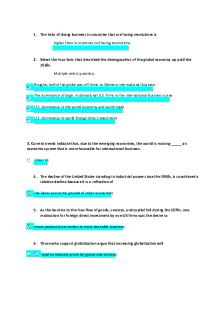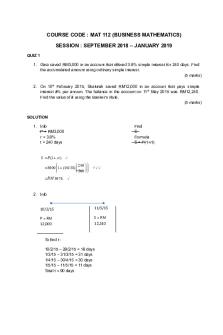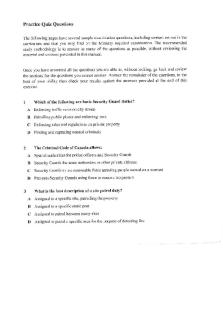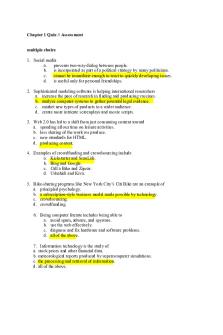HW 1 - Quiz Practice PDF

| Title | HW 1 - Quiz Practice |
|---|---|
| Course | International Marketing |
| Institution | Central Piedmont Community College |
| Pages | 7 |
| File Size | 179.9 KB |
| File Type | |
| Total Downloads | 20 |
| Total Views | 174 |
Summary
Quiz Practice...
Description
1. The risks of doing business in countries that are facing revolutions is higher than in countries not facing revolutions.
2. Select the four facts that described the demographics of the global economy up until the 1960s. Multiple select question. Roughly half of the globe was off-limits to Western international business The dominance of large, multinational U.S. firms in the international business scene U.S. dominance in the world economy and world trade U.S. dominance in world foreign direct investment
3. Current trends indicate that, due to the emerging economies, the world is moving _____ an economic system that is more favorable for international business. closer to
4. The decline of the United States standing in industrial power since the 1960s, is considered a relative decline because it is a reflection of the faster economic growth of other economies
5. As the barriers to the free flow of goods, services, and capital fell during the 1970s, one motivation for foreign direct investment by non-US firms was the desire to move production activities to more desirable locations.
6. Those who support globalization argue that increasing globalization will lead to reduced prices for goods and services.
7. A(n) ______ is any entity that conducts business in at least two countries. multinational enterprise
8. Some demonstrations against globalization are based on the idea that falling barriers to international trade result in job losses in industries targeted by foreign competitors.
9. Former communist nations present opportunities to Western international business as these nations show continued commitment to _____. Democracy
10. The opponents of globalization argue that falling barriers to international trade will eliminate manufacturing jobs in wealthy economies.
11. If you were to describe the global economy of the twenty-first century, it would be accurate to say that more nations are becoming part of the developed world.
12. When NAFTA was first introduced, what was the biggest argument opponents presented? U.S. firms would move manufacturing to Mexico and feel free to pollute the air and employ child labor.
12. In the early 1960s, the U.S. was the world's dominant industrial power. How does the U.S. position compare today? It has diminished industrial power.
13. Supporters of globalization argue that bodies such as the World Trade Organization and the United Nations exist to serve the collective interests of member states, not to subvert those interests. True
14. Influential economists, politicians, and business leaders who favor globalization argue That falling barriers to international trade drive the economy toward greater prosperity.
15. According to critics of globalization, increased free trade and investment over the past few decades have broadened the gap between the rich and poor nations.
16. Critics of globalization protest in order to diminish the impact of the culture of multinational enterprises on the world.
17. Brite-Way Lighting is based in California and sells products within the United States as well as to ten foreign countries. Brite-Way Lighting is an example of a(n) _____ business. international
18. According to the critics of globalization, what are two results from falling trade barriers? A depression of wages in developed nations
The destruction of manufacturing jobs in advanced economies
19. Critics of globalization point out that free trade allows firms to abuse the weak labor and environmental laws in developing countries
20. One concern voiced by critics of globalization is that
an interdependent global economy shifts economic power away from national governments and toward organizations such as the United Nations.
21. The division between rich and poor nations has advent of globalization?
(increased or decreased?) with the
increased
22. A(n) ______ business is any firm that engages in cross-border trade or investment. International
Chapter 1: Click and Drag ExercisesAssignment Global Institutions Since the middle of the 20th century, the international global business system has been shaped by global institutions. Countries have established these institutions to address the global issues that span their borders. The functions of these organizations have been established in international treaties. International businesses need to be aware of the functions of these organizations as they can have a profound impact on trade and commerce. It is critical for businesses to understand the responsibilities of each organization as well as the rationale for its creation.
a. The IMF and World Bank were created in 1944 by 44 nations that met to maintain order in the international monetary system and promote economic growth. Bretton woods institutions: IMF and the World Bank (Organization)
b. As much as 70 percent of its work is devoted to establishing higher standards of living, full employment, and conditions of economic and social progress and development. UN (Organization)
c. A series of treaties that reduced barriers to trade. GATT (Organization)
d. Primarily responsible for policing world trading system. WTO (Organization)
e. Finance ministers and central bank governors of major economies coordinate policy on global financial crises. GTO (Organization)
Drivers of Globalization Since World War II, globalization has been driven by two major factors: the decline in barriers to the free flow of goods, services, and capital, and technological change. Business has fueled these trends and has been the beneficiary of these trends. Understanding globalization trends helps businesses identify opportunities and threats in their environment. Understanding these trends will also make the changes much more manageable. International businesses have greater flexibility, more options, and a broader scope to consider globalization of production and globalization of markets.
A. Declining Trade Barriers (Driving Force) – better ability to export goods (Implication for Business) B. Declining investment barriers (Driving Force) – better ability to optimize location economies (Implication for Business)
C. Enhanced communication technologies (Driving Force) – growth in e-commerce (Implication for Business)
D. Enhanced transportation technologies lowered distance between countries
(Implication for Business)
Demographics of the Global Economy Some fairly dramatic changes have taken place in the demographics of the global economy over the past three decades. Several factors have played a significant part in shaping this change. Since the 1960s, four major factors have contributed to the changing world economy and the world trade picture. These factors are U.S. dominance in the world economy, U.S. dominance in world foreign direct investment, dominance of large multinational U.S. firms, and lack of trade with centrally planned economies. All of these have either changed, or are rapidly changing the global economy of today.
A. The Changing World Output and World Trade Picture – Developing Countries (It estimated that today’s developing nations may account for more than 60 percent of world economic activity by 2025, while rich nations’ economic activity, currently at 55 percent, may decline to 38 percent.)
b. The Changing FDI Picture – Toyota (Toyota rapidly increased its investment in auto production facilities in the United States and Europe during the late 1980s and early 1990s)
c. The Changing Nature of the Multinational Enterprise – Wanda Group (One of the world’s largest real estate companies, the Dalian Wanda Group, hopes to become a world class multinational by 2020. Already, the company, which began in China in 1988, has assets in the United States, the United Kingdom, Australia, and Spain)
d. The Changing World Order –
China (China continues to move towards greater free market reforms. If this continues for two more decades, China may move from third-world to industrial superpower more rapidly than Japan did.)...
Similar Free PDFs

HW 1 - Quiz Practice
- 7 Pages

HW QUIZ 1 - quiz 1
- 5 Pages

FIN6406 Chapter 1 Practice HW
- 11 Pages

Sample Quiz #1 - Practice Quiz
- 2 Pages

Patho Practice Quiz 1
- 5 Pages

Chapter 1 - quiz practice
- 5 Pages

Practice Quiz 1
- 2 Pages

QUIZ 1 MAT112 Practice
- 2 Pages

Practice Quiz 1 - Exam
- 24 Pages

Practice Quiz 1
- 11 Pages

HW QUIZ 3 - quiz 3
- 2 Pages

Hw 1 - quest hw
- 9 Pages

MGT2381 Chapter 1 Practice Quiz
- 6 Pages
Popular Institutions
- Tinajero National High School - Annex
- Politeknik Caltex Riau
- Yokohama City University
- SGT University
- University of Al-Qadisiyah
- Divine Word College of Vigan
- Techniek College Rotterdam
- Universidade de Santiago
- Universiti Teknologi MARA Cawangan Johor Kampus Pasir Gudang
- Poltekkes Kemenkes Yogyakarta
- Baguio City National High School
- Colegio san marcos
- preparatoria uno
- Centro de Bachillerato Tecnológico Industrial y de Servicios No. 107
- Dalian Maritime University
- Quang Trung Secondary School
- Colegio Tecnológico en Informática
- Corporación Regional de Educación Superior
- Grupo CEDVA
- Dar Al Uloom University
- Centro de Estudios Preuniversitarios de la Universidad Nacional de Ingeniería
- 上智大学
- Aakash International School, Nuna Majara
- San Felipe Neri Catholic School
- Kang Chiao International School - New Taipei City
- Misamis Occidental National High School
- Institución Educativa Escuela Normal Juan Ladrilleros
- Kolehiyo ng Pantukan
- Batanes State College
- Instituto Continental
- Sekolah Menengah Kejuruan Kesehatan Kaltara (Tarakan)
- Colegio de La Inmaculada Concepcion - Cebu


